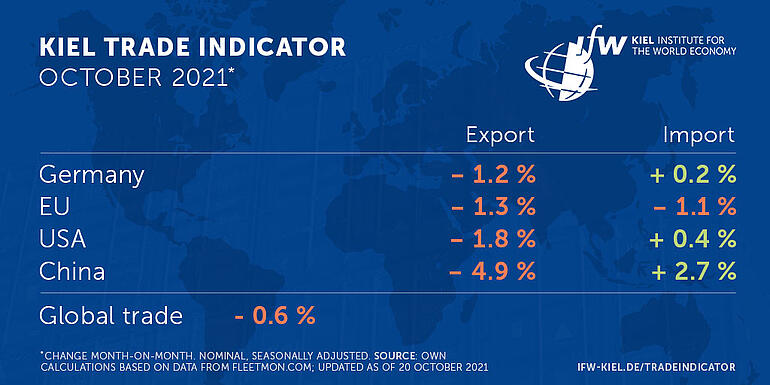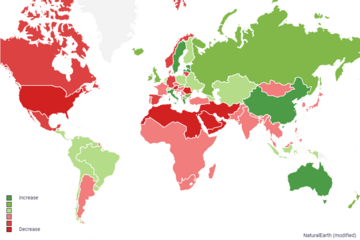News
Kiel Trade Indicator: Trade outlook dims, congestion threatens to worsen

China's trade remains at the same level as in the spring. The Kiel Trade Indicator signals a decline of 4.9 percent in exports in October compared to the previous month (nominal, seasonally adjusted) and an increase of 2.7 percent in imports.
U.S. trade has been declining slightly since the spring. For exports in October, the Kiel Trade Indicator shows a minus of 1.8 percent, for imports a very slight plus of 0.4 percent.
Germany's imports declined significantly in the summer and have not yet recovered, with the Kiel Trade Indicator signaling a mere break-even of +0.2 percent in October. Exports are expected to fall by 1.2 percent. For the EU, the Trade Indicator shows a reduction in exports (-1.3 percent) and imports (-1.1 percent).
World trade is expected to decline slightly in October (-0.6 percent).
“Global trade is lacking a positive impulse to move forward. It is currently stuck at the level before the outbreak of the Covid-19 crisis and has now been stagnating for an unusually long time,” says Vincent Stamer, Head of Kiel Trade Indicator. “Looking at the congestion of container ships dims hopes of a timely increase. For the first time, freighters are now congesting off the major seaports of China and the U.S. at the same time to a worrying extent.”
While the congestion off the Chinese port of Ningbo-Zhoushan has eased somewhat since all terminals are back in operation, the rush of container ships in the Pearl River Delta has intensified. Congestion from container ships is increasing significantly off the ports of the US. Almost three percent of global cargo capacity is stuck off Los Angeles and Long Beach, and over two percent off Savannah.


Around 9 percent of freight capacity worldwide is tied up in these major container congestions, including empty container ships waiting to be loaded. More than 3 percent of all goods shipped by sea are stuck in waiting ships. Cargo volumes in the Red Sea—the most important sea trade route between China and Europe—are currently about 10 percent lower than would be expected under normal circumstances.
Stamer: “In response to increased demand and supply bottlenecks, many large retailers and manufacturing companies are currently ordering goods to replenish stocks, which further ties up the limited capacities in the transport network. Signs of normalization are unlikely to emerge until after the Chinese New Year in the first half of 2022, and the situation could ease across the board from summer at the earliest. For Christmas, we can expect limited product choice and higher prices, especially for electronic products.”
For more information on the Kiel Trade Indicator and forecasts for 75 countries, visit here.
The next update of the Kiel Trade Indicator will take place on November 4 (without press release) November 22 (with press release).

About the Kiel Trade Indicator
The Kiel Trade Indicator estimates trade flows (imports and exports) for 75 countries worldwide, the EU and world trade as a whole. It is based on the evaluation of ship movement data in real time. An algorithm programmed at the Kiel Institute uses artificial intelligence to analyze the data and translates the ship movements into nominal, seasonally adjusted growth figures compared with the previous month.
We update the data twice a month. Around the 20th (with press release) for the current and the following month and around the 3rd (without press release) for the previous and the current month.
Arriving and departing ships are recorded for 500 ports worldwide. In addition, ship movements in 100 maritime regions are analyzed and the effective utilization of container ships is derived from draught information. Country-port correlations can be used to generate forecasts, even for countries without their own deep-sea ports.
Compared to previous leading trade indicators, the Kiel Trade Indicator is available much earlier, is much more comprehensive, relies on a uniquely large database using big data, and has a low statistical error by comparison. The algorithm of the Kiel Trade Indicator uses machine learning, so that the quality of the forecast continues to improve over time.
